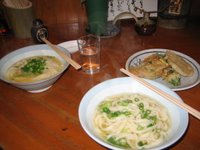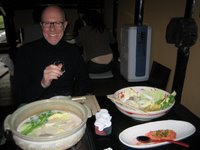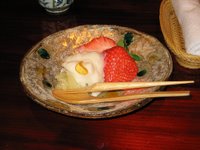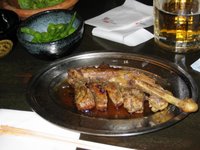 When we visited Hiroko's father in Kagawa-ken, he took us to his favorite chicken joint, Ikkaku in Marugame-city. When he was a young salaryman in the 70's, he and his co-workers had made it their payday ritual to meet there to eat, drink, talk about the stresses of their job and unwind. Since it first opened in 1967 this izakaya has become so immensely popular for its signature dish, that it has spawned branches not only on its home turf, the island of Shikoku, but also across the country in Yokohama City (near Tokyo) and soon in Osaka as well.
When we visited Hiroko's father in Kagawa-ken, he took us to his favorite chicken joint, Ikkaku in Marugame-city. When he was a young salaryman in the 70's, he and his co-workers had made it their payday ritual to meet there to eat, drink, talk about the stresses of their job and unwind. Since it first opened in 1967 this izakaya has become so immensely popular for its signature dish, that it has spawned branches not only on its home turf, the island of Shikoku, but also across the country in Yokohama City (near Tokyo) and soon in Osaka as well.Now, about that signature dish.....Hiroko's father awkwardly warned us in advance that Ikkaku's chicken is "nothing like that ordinary tender grilled chicken. This chicken is much chewier and so much better." We didn't quite know what to expect, but told him we were game to try it...after all if it was little chewy but more flavorful, why not? Well...
Ikkaku's menu is short, simple, and straightforward consisting of "Oyadori" (adult chicken), "Hinadori" (young chicken), and a few other small dishes like edamame, salad, chicken rice, and soup. Needless to say, this simple kind of food was meant to be eaten with continuously flowing beer, sake, and/or shochu.
 At Hiroko's father's insistence, we started with a beer and the Oyadori (adult chicken). A plate bearing a chicken leg and thigh arrived in front of each of us. The chicken was redolent of garlic, oil, and a blend of black and red pepper. It looked and smelled delicious. The scent of the glistening spicy grilled meat made us salivate immediately. Rick bit into the chicken. The meat didn't budge from the bone.. It became apparent that Hiroko's father's warning was no understatement. This Oyadori was not the least bit tender at all; and was just the kind of "tough chicken" that would make a tender man of Frank Perdue (or at least be his nightmare). But, the flavor of the chicken was so irresistably tasty and toothsome that it was next to impossible to stop attacking and chewing the meat....maybe it brought out the deeply buried primeval satisfaction of the early carnivores. Our fingers were covered with juice and our lips were happily buzzing with spices from the marinade. We had to keep licking our fingers, it was senseless to continue to try to use napkins.
At Hiroko's father's insistence, we started with a beer and the Oyadori (adult chicken). A plate bearing a chicken leg and thigh arrived in front of each of us. The chicken was redolent of garlic, oil, and a blend of black and red pepper. It looked and smelled delicious. The scent of the glistening spicy grilled meat made us salivate immediately. Rick bit into the chicken. The meat didn't budge from the bone.. It became apparent that Hiroko's father's warning was no understatement. This Oyadori was not the least bit tender at all; and was just the kind of "tough chicken" that would make a tender man of Frank Perdue (or at least be his nightmare). But, the flavor of the chicken was so irresistably tasty and toothsome that it was next to impossible to stop attacking and chewing the meat....maybe it brought out the deeply buried primeval satisfaction of the early carnivores. Our fingers were covered with juice and our lips were happily buzzing with spices from the marinade. We had to keep licking our fingers, it was senseless to continue to try to use napkins.
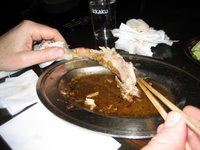 Hiroko's father believes that once people have the Ikkaku experience, it is difficult to go back to eating tender chicken...it is almost as if tender chicken does not have the flavor or provide the satisfaction that should come from eating this farmyard (or probably freerange in this case) fowl. And, as we cleaned the last bits of meat from the bones, we could clearly understand why he felt that way. After the Oyadori, we ordered some "Hinadori" (young chicken) for comparison...yes, it was juicy and tasty, but somehow now it just seemed ordinary.
Hiroko's father believes that once people have the Ikkaku experience, it is difficult to go back to eating tender chicken...it is almost as if tender chicken does not have the flavor or provide the satisfaction that should come from eating this farmyard (or probably freerange in this case) fowl. And, as we cleaned the last bits of meat from the bones, we could clearly understand why he felt that way. After the Oyadori, we ordered some "Hinadori" (young chicken) for comparison...yes, it was juicy and tasty, but somehow now it just seemed ordinary.



